|
|
|
Sort Order |
|
|
|
Items / Page
|
|
|
|
|
|
|
| Srl | Item |
| 1 |
ID:
110501
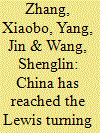

|
|
|
|
|
| Publication |
2011.
|
| Summary/Abstract |
In the past several years, labor shortage in China has become an emerging issue. However, there is heated debate on whether China has passed the Lewis turning point and entered a new era of labor shortage from a period of unlimited labor supply. Most empirical studies on this topic focus on the estimation of total labor supply and demand. Yet the poor quality of labor statistics leaves the debate open. In this paper, China's position along the Lewis continuum is examined though primary surveys of wage rates, a more reliable statistic than employment data. Our results show a clear rising trend of real wages rate since 2003. The acceleration of real wages even in slack seasons indicates that the era of surplus labor is over. This finding has important policy implications for China's future development model.
|
|
|
|
|
|
|
|
|
|
|
|
|
|
|
|
| 2 |
ID:
110500


|
|
|
|
|
| Publication |
2011.
|
| Summary/Abstract |
This study examines the conventional wisdom that off-farm employment contributes to environmental pollution by increasing the use of agro-chemicals. In order to analyse the role of household decision making and village factor markets in more detail, we run simulations with a hybrid farm household/village computable general equilibrium model that is applied to a village in Northeast Jiangxi Province. We find that the negative lost-labour effect of off-farm employment on agricultural incomes is much stronger than the (small) positive income effect. As a result of reduced labour resources and increased leisure consumption, farm households reduce the intensity of rice cultivation as well as the production of (especially) cash crops. The shift in production activities is stronger for migration than for off-farm employment, because migrants cannot combine off-farm work with onfarm work, and because migration reduces the village market price of oxen services. The shift towards less intensive rice production means that off-farm employment (and migration in particular) reduces the levels of chemical inputs and manure used in agricultural production. The decline in fertilizer input is much larger than the decline in manure use, because manure is a nontradable commodity and is applied only once per year. We therefore conclude that migration and, to a lesser extent, local off-farm employment lead to lower incomes from agricultural production, but have benign effects on environmental quality.
|
|
|
|
|
|
|
|
|
|
|
|
|
|
|
|
| 3 |
ID:
110502


|
|
|
|
|
| Publication |
2011.
|
| Summary/Abstract |
Many recent studies claim that China has reached a Lewisian 'turning point' in economic development, signalled by rising wages in urban areas and the exhaustion of rural surplus labour. In this paper we show that despite some evidence of rising nominal urban unskilled wages between 2000 and 2009, there is little in the data to suggest that this wage increase has been caused by unskilled labour shortages. China still has abundant under-employed workers with very low income in the rural sector. We argue that China's unique institutional and policy-induced barriers to migration have both prevented many rural workers from migrating to cities and also reduced the migrants' length of stay. We project that under alternative institutional settings, the migrant stock could easily be doubled from the current 150 million to 300 million by increasing either the average length of migrant stay, or the migrant inflow, or both.
|
|
|
|
|
|
|
|
|
|
|
|
|
|
|
|
| 4 |
ID:
110498
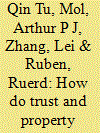

|
|
|
|
|
| Publication |
2011.
|
| Summary/Abstract |
Trust and property rights are generally considered to influence farmers' behavior regarding resource use and environmental management. Previous studies show that higher trust levels may enhance contributions to public goods. This paper investigates how trust and (land) property rights security influence the provision of one concrete public good: land protection through the Sloping Land Conservation Program in China. The analysis is based on household survey data from Ningxia Autonomous Region in China. From our questionnaire two trust factors are derived and distinguished, using factor analysis: general trust and kinship trust. Farm households are less likely to contribute to public goods when they perceive more secure land rights, but trust has mixed effects on public goods. The results show that general trust and kinship trust may rely on two opposite effects for influencing public goods provision. On the one hand, high levels of general trust may directly enhance people's willingness to provide contributions to public goods (by reduced likelihood to reconvert forest land) when farmers are aware of the positive environmental effects of the program, that's the public goods effect. On the other hand, general trust may also make it more likely that people invest more in their own private goods to pursue their own welfare (a more likely reconversion of forest land to arable land), that's the private goods effect. The final outcome depends on the size and direction of both effects. Compared to general trust, kinship trust is more inward-looking and self- or group-interested compared to more reciprocal general trust. Thus, unlike general trust, kinship trust may have no significant public goods effect on the provisioning of public goods.
|
|
|
|
|
|
|
|
|
|
|
|
|
|
|
|
| 5 |
ID:
110507


|
|
|
|
|
| Publication |
2011.
|
| Summary/Abstract |
Since China's transition to a market economy, the labour productivity growth has been dramatically rapid, in particular since 1994. This speeding up has been accompanied by the reverse of the exchange rate policy of China, which has strongly depreciated its currency before 1994, and then either appreciated or stabilized it. The theoretical arguments suggesting several kinds of real exchange rate impact on labour productivity are developed. An econometric model is then proposed and estimated, using panel data for the twenty-nine Chinese provinces and for the period from 1986 to 2007. The econometric results show that the appreciation of the real exchange rate had a favourable effect on the labour productivity growth, leading to a kind of virtuous circle: the real appreciation of the currency boosts the growth of labour productivity while, according to the Balassa-Samuelson effect, productivity growth tends to push up the real appreciation. Moreover, this favourable effect is stronger in inland provinces than in coastal provinces, contributing to a minimizing of the gap between inland and coastal provinces.
|
|
|
|
|
|
|
|
|
|
|
|
|
|
|
|
| 6 |
ID:
110497
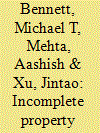

|
|
|
|
|
| Publication |
2011.
|
| Summary/Abstract |
This paper uses data from a 2003 rural survey to examine the determinants of household provision of environmental services under China's Sloping Land Conversion Program (SLCP), the largest payments for environmental services program in the developing world. The paper examines the determinants of plot-level survival rates of program-planted trees and grasses. It finds that household rights over retired land as well as autonomy in program decision-making (which we argue on the basis of supportive evidence are plausibly exogenous to post-retirement outcomes) have important and potentially countervailing impacts on the provision of environmental services targeted by the program. Households permitted to select what to plant obtain better program outcomes, but do not make the choices that the government would like them to, while those permitted to decide what land to retire perform worse. The analysis also finds that households more vested and experienced in agriculture and with less exposure to off-farm labor markets fare better in managing their planted trees. Significant learning-by-doing effects are also evident, suggesting that greater technical support to farmers could improve outcomes and lower program costs.
|
|
|
|
|
|
|
|
|
|
|
|
|
|
|
|
| 7 |
ID:
110506


|
|
|
|
|
| Publication |
2011.
|
| Summary/Abstract |
This paper assesses the applicability of two alternative theories in understanding labor market developments in China: the classical view featuring a Lewis turning point in wage growth versus a neoclassical framework emphasizing rational choices of individuals and equilibrating forces of the market. Empirical evidence based on multiple data sources fails to validate the arrival of the Lewis turning point in China, showing continuous and coordinated wage growth across rural and urban sectors instead. Consistent with the neoclassical view, we find that rural workers expanded off-farm work when mobility restrictions were lifted, interprovincial migration responded to expected earnings and local employment conditions, and returns to education converged gradually to the international standard. These findings suggest major progresses in the integration of labor markets in China.
|
|
|
|
|
|
|
|
|
|
|
|
|
|
|
|
| 8 |
ID:
110495


|
|
|
|
|
| Publication |
2011.
|
| Summary/Abstract |
Grain self-sufficiency is one of the most important agricultural policy goals in China. With only modest imports, China has succeeded in feeding 22% of the world's population on only 7% of its land. However, a high price has been paid for this enormous achievement. Increase in grain yields, in particular in rice, as the main source of production growth, relied heavily on intensive use of physical inputs and increasing intensity of farming systems. Soil degradation, water scarcity, and severe pollution were among the consequences as well as declining efficiency of fertilizer application. Using county-level panel data from 1980 to 2003 and graphical (GIS-based) analysis, this paper first looks at the spatial change of the major grain production across regions over the past two decades, towards the northern and northeastern provinces. The analysis is complemented by using a random panel data model, which underscores the significant influence of land availability, degree of urbanization, and government policy on grain production. Finally, this analysis addresses environmental stress which includes both soil degradation and water shortage. The latter is already severe in many of the traditional grain producing areas, but will now become a bigger problem in the "new" grain producing areas, as these have traditionally much less water resources. Hence, while the economic rational of the "grain shift" towards the northern and northeastern regions is understandable, its sustainability is not guaranteed.
|
|
|
|
|
|
|
|
|
|
|
|
|
|
|
|
| 9 |
ID:
110509
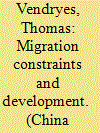

|
|
|
|
|
| Publication |
2011.
|
| Summary/Abstract |
Rural-urban migration flows are a crucial corollary of economic development. The adverse or beneficial effects of internal migration, for sending as well as receiving areas, and the definition of optimal migration policies, have remained much discussed issues since the seminal works of Harris and Todaro (1970). This debate is especially acute in China where the "household registration system" (hukou) acts as a strong constraint on individual migration. This paper aims to assess the consequences of hukou through a simple model of a developing dual economy with overlapping generations. Contrary to existing studies focused on the contemporaneous allocation of economic resources, it deals with the dynamic consequences of migration flows and migration policies. It shows that, in fairly general circumstances, hukou-related migration constraints can actually hasten development, understood as the transfer of the labor force to the modern sector, driven by capital accumulation. The hukou system could thus be one of the causes of the extremely high Chinese saving rate and of the high pace of Chinese development. Insights from the model are confronted with stylized facts from the Chinese development, and theoretical results are especially consistent with the effects of the 2001 "towns and small cities" reform.
|
|
|
|
|
|
|
|
|
|
|
|
|
|
|
|
| 10 |
ID:
110508


|
|
|
|
|
| Publication |
2011.
|
| Summary/Abstract |
Most studies have reported non negligible improvements for China in terms of poverty during the last three decades. However, this result is potentially hampered by two limitations. First, it may be contingent to the specific choices made regarding the poverty line and the poverty indices used for the analysis. As a consequence, it may collapse if one uses alternative poverty lines or poverty measures. Second, it results from a focus on the sole monetary aspects of poverty. As income does not cover all facets of well-being and since the relationship between these two concepts are quite fuzzy, it may be worth using a broader view of well-being, hence opting for a multidimensional approach of poverty analysis. In the present paper, these two issues are addressed using multidimensional stochastic dominance procedures on the joint distribution of income, education and health in seven Chinese provinces.
|
|
|
|
|
|
|
|
|
|
|
|
|
|
|
|
| 11 |
ID:
110499


|
|
|
|
|
| Publication |
2011.
|
| Summary/Abstract |
This paper discusses the determinants of firewood consumption in a poor township in rural northern China, with a special focus on the relationship between households' economic wealth and firewood consumption. We find strong support for the poverty-environment hypothesis since household economic wealth is a significant and negative determinant of firewood consumption. Firewood can therefore be considered as an inferior good for the whole population in the rural area under study, although further evidence shows that at the top of the wealth distribution, there might be a floor effect in the decreasing firewood consumption. Besides economic wealth, our analysis also shows that the own-price effect is important in explaining firewood consumption behavior, the price effect gaining importance with rising incomes. Finally, increasing education is also found to be a key factor in energy consumption behavior, especially when dealing with energy source switching behavior.
|
|
|
|
|
|
|
|
|
|
|
|
|
|
|
|
| 12 |
ID:
110504
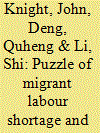

|
|
|
|
|
| Publication |
2011.
|
| Summary/Abstract |
The paper examines the contentious issue of the extent of surplus labour that remains in China. China was an extreme example of a surplus labour economy, but the rapid economic growth during the period of economic reform requires a reassessment of whether the second stage of the Lewis model has been reached or is imminent. The literature is inconclusive. On the one hand, there are reports of migrant labour scarcity and rising migrant wages; on the other hand, estimates suggest that a considerable pool of relatively unskilled labour is still available in the rural sector. Yet the answer has far-reaching developmental and distributional implications. After reviewing the literature, the paper uses the 2002 and 2007 national household surveys of the Chinese Academy of Social Sciences to analyse and explain migrant wage behaviour, to predict the determinants of migration, and to examine the size and nature of the pool of potential rural-urban migrants. An attempt is also made to project the rural and urban labour force and migration forward to 2020, on the basis of the 2005 1% Population Survey. The paper concludes that for institutional reasons both phenomena are likely to coexist at present and for some time in the future.
|
|
|
|
|
|
|
|
|
|
|
|
|
|
|
|
| 13 |
ID:
110503


|
|
|
|
|
| Publication |
2011.
|
| Summary/Abstract |
When examining questions regarding the Lewis model, one of the most salient set of facts involves the shift of labor between agricultural and the off farm sectors. The goal of this paper is to answer several questions about the nature of this movement: How has the expansion of the economy after 2000 affected off farm labor market participation? Has off farm labor continued to rise? What is this rise being driven by-migrant wage earners or self employment opportunities? What is, in part, driving these trends? Using a national representative set of data that consists of two waves of surveys done in 2000 and 2008 in six provinces, the paper finds that off farm labor market participation has continued to rise steadily in the early 2000s. However, there has been a structural break in the trends of occupational choice before and after 2000. Unlike before 2000, after 2000 migration's growth accelerated; during this same period the self employed subsector stagnated. The number of wage earning migrants in 2008 was greater than the number of those in the self employed subsector. The data also show that the rise in wage-earning migration is mainly being driven by the younger cohorts. Our analysis also shows that the rise of migration is happening in conjunction with a rising unskilled wage.
|
|
|
|
|
|
|
|
|
|
|
|
|
|
|
|
| 14 |
ID:
110496
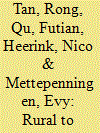

|
|
|
|
|
| Publication |
2011.
|
| Summary/Abstract |
The current system of converting farmland to urban land use in China can be characterized as a hybrid system that combines government controls with market-based transfers. In this paper we argue that this hybrid governance structure causes an over-conversion of farmland from the rural to the urban sector, as compared to a competitive market situation, and a welfare reallocation that discriminates against farmland owners. We develop a partial equilibrium model that can be used to examine the impact of the current hybrid governance structure on the over-conversion of farmland and to analyze the welfare changes for different groups of actors and the resulting net social welfare loss. Using a dataset with detailed information on farmland acquisitions and urban land transactions in Yingtan City in Jiangxi Province, we illustrate how this framework can be applied. Our results indicate an over-conversion of 33.5% of the total converted farmland in this city between 1999 and 2003. The welfare of farmland owners affected by the conversion decreased by 1.38 billion RMB, while the net social welfare loss equaled more than 270 million RMB during the same period. The local government obtained 380 million RMB of revenues by re-selling farmland as urban land through competitive conveyance mechanisms between 2002 and 2005, while the manufacturing sector gained an estimated 280 million RMB from buying land use rights at relatively low prices. We conclude that the current policy of increasing urban land conveyance through competitive mechanisms does not address two major underlying causes of over-conversion, and that protection of farmland would be better served by replacing the current hybrid rural to urban land market structure by a competitive land market.
|
|
|
|
|
|
|
|
|
|
|
|
|
|
|
|
| 15 |
ID:
110494


|
|
|
|
|
| Publication |
2011.
|
| Summary/Abstract |
In this paper we provide an overview of recent trends in the availability and quality of land and water resources in rural China, and examine the common presumption that rural resources are rapidly degrading in China. Data based on consistent definitions and measurement methods that have recently become available are used to that end. In addition, we analyse the impact of new policy initiatives to introduce market-based instruments and new institutions to address land degradation and water scarcity problems.
We find that the decline in cultivated area has accelerated in the beginning of the new century. Ecological recovery programs, not urbanization and industrialization, are the major factors causing this decline. Ecological recovery programs are also a major force behind the increase in forest land area and the reduction of water erosion. Modest successes can be observed in the protection of wetlands and (until the mid-1980s) for the average quality of cultivated land. On the other hand, degradation of natural grassland and wind erosion have become much more severe in recent decades.
In northern China, particularly in the 3-H (Hai and Luan, Huai and Huang) river basins, the availability of water has tightened. Groundwater tables have fallen considerably in the Hai river basin, because farmers increasingly rely on groundwater for irrigation. Evidence on other parts of northern China is mixed. Pollution of surface water is getting worse since the beginning of the 1990s in two major lakes in southern China and until recently in the rivers in northern China. Water quality problems in the larger rivers in southern China are less severe and getting less. These problems are to a large extent caused by agriculture-based non-point source pollution, especially in the major lakes and reservoirs.
The sloping land conversion program, water pricing, and the establishment of water user associations and payments for environmental service projects are used as cases to examine the introduction of market-based instruments and new institutions. We argue that less government interference in the implementation of these instruments and institutions is likely to enhance ecological as well the economic benefits. Moreover, supportive measures to improve the functioning of land and labor markets are usually needed to ensure the sustainability of the impact of interventions.
|
|
|
|
|
|
|
|
|
|
|
|
|
|
|
|
| 16 |
ID:
110505


|
|
|
|
|
| Publication |
2011.
|
| Summary/Abstract |
We examine the wage trends of ordinary workers and the wage convergence between unskilled and skilled workers in China. First, we find that wages in all non-agricultural sectors, wages of migrant workers, and wages of hired workers in the agricultural sector have increased dramatically since 2003. Second, through comparing wage differentials between migrant and urban resident workers and between heterogeneous education groups within migrant workers, and by investigating the changes in the contribution of the returns to education to wage differentials, we find that the wages of unskilled and skilled workers have converged. Both the increasing wage trends and wage convergence are interpreted as evidence supporting the hypothesis that China has passed what can be called the Lewis turning point in the industrial sector. We conclude that the sustainability of economic growth in China requires an upgrading of labor market institutions to accommodate the merging of the rural and urban labor forces.
|
|
|
|
|
|
|
|
|
|
|
|
|
|
|
|
|
|
|
|
|